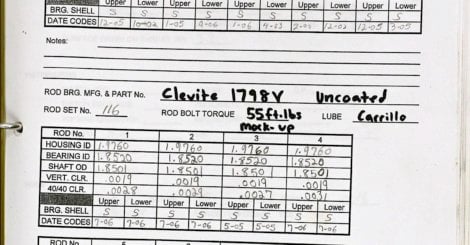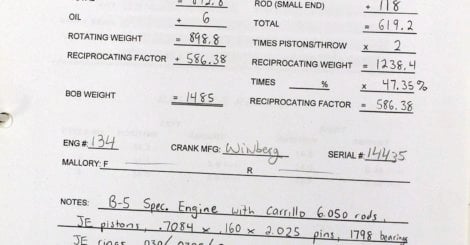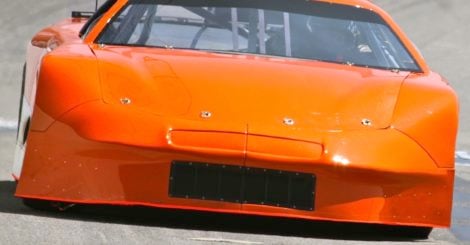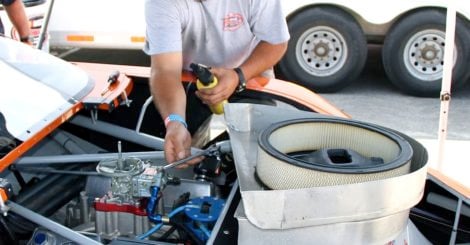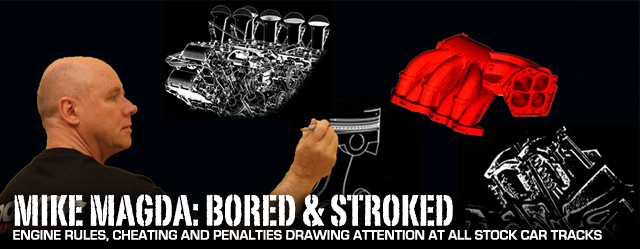 [1]NASCAR’s crackdown on the Joe Gibbs Racing engine that powered Matt Kensenth to victory in the STP 400 at Kansas Speedway in April certainly sends a message to engine builders to double- and triple-check specs. It doesn’t make a difference if the infraction actually provides a competitive advantage; rules are rules, and NASCAR officials say there will be no judgement of the infraction — just enforcement.
[1]NASCAR’s crackdown on the Joe Gibbs Racing engine that powered Matt Kensenth to victory in the STP 400 at Kansas Speedway in April certainly sends a message to engine builders to double- and triple-check specs. It doesn’t make a difference if the infraction actually provides a competitive advantage; rules are rules, and NASCAR officials say there will be no judgement of the infraction — just enforcement.
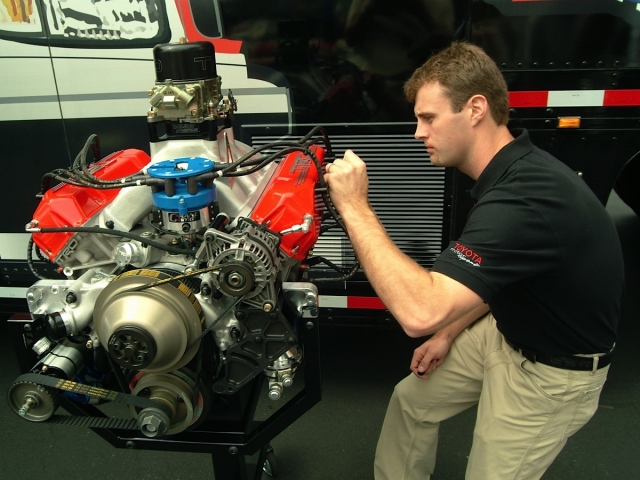 [2]
[2]Toyota Racing Development is reportedly reviewing internal procedures to ensure illegal parts aren’t used again. This archive photo shows Toyota’s first generation NASCAR engine.
Officials found a single connecting rod three grams too light following a post-race teardown, and then the sanctioning body levied some of the harshest fines and penalties to date on Hamlin and JGR — even though they had nothing to do with the engine build. The engine supplier, Toyota Racing Development, assumed full responsibility for the error; however, NASCAR says it has no authority or channel to penalize TRD. It’s still the responsibility of the car owner and crew chief to ensure their driver is running a legal setup. Eventually, the penalties were reduced through appeal, but NASCAR tech officials made a definite statement.
Three grams are nothing. That’s a tenth of an ounce. The rotating assembly is affected more by a droplets of oil than that small weight difference between a single rod and its seven brothers. NASCAR has strict rules on the weight and material makeup of the connecting rod to discourage the use of exotic materials, however, suppliers can use sophisticated modeling software to develop rod designs that maximize certain strength and rotating dynamics.
These engine rules and their strict interpretation often beg the question of just how to apply penalties fairly. The Gibbs organization was hit hard with fines and loss of championship points. It was only through the appeals process that the punitive actions were reduced, with officials saying that the penalties didn’t match the infraction. Intent, apparently, was a major factor that the appeals panel considered. There simply was no competitive advantage to the single lightweight rod.
Tighter inspections in engine shop
According to an Associated Press story [3], TRD is backtracking to identify any other non-legal parts in its inventory and review the parts acquisition procedures. As part of the probe, TRD recalled three engines from Michael Waltrip Racing shortly after the Kansas race, just to be sure no other inspections would lead to more penalties. However, exactly how both the supplier and the engine shop missed the lightweight part remains a mystery to the public. If you’ve ever seen a NASCAR engine build book, you know there are checks and backup checks for everything. We got a peek inside part of a build book for a Dodge NASCAR engine that was built in 2006 [4], and the routine was quite involved then.
By now on the Cup level, those routines are more precise with even more resources for verification. Think back to when Junior Johnson’s car was caught with an oversized engine in the early ‘90s? He had to sit out a four-week suspension when his engine builder mistakenly picked up the wrong crankshaft in haste to prepare for the race and the engine ended up at just under 362ci, a tick over the minimum 358ci. His driver didn’t even finish in the top 10, but NASCAR imposed a stiff penalty, which was later reduced on appeal. But with record keeping and strict backup measures in place, shops would have no excuse for such a “mistake” today.
Here are a couple of pages from a 2006 Dodge NASCAR engine build book. Records are kept for every dimension, clearance and weight, and there are backup checks during the assembly process. By now these inspection and verification procedures are even more stringent.
The recent events also underline NASCAR’s commitment to transparent post-race inspections. Remember in 2000 when NASCAR tore down Rusty Wallace’s engine at Sonoma in front everyone, including fans in the garage area? It’s not that dramatic today, but the engines of every winner and runnerup of each NASCAR division gets a post-race teardown with corresponding team reps in attendance. And tricks like Darrell Waltrip grenading his engine after getting the checkered flag in a mid-‘80s race — supposedly to leave nothing for officials to measure — won’t work today. The NASCAR technical center is fully equipped to sniff out even the smallest infraction.
Unfortunately, that’s not the case at smaller tracks. They often don’t have facilities or personnel to check and measure all engine components for every winner. These post-race inspections are more likely at the discretion of local tech officials, unless an opposing driver files protest. And the racing climate at most tracks often dictates that drivers don’t protest each other. Instead, it usually takes a hard-nosed tech official with a keen eye for engine discrepancies to make judgement calls. Their jobs get harder at tracks where “spec” engines — those built and sealed by an authorized builder using specified parts — run against “open” engines, or those built by independent engine builders according to the rules.
Spec engine dilemma
The cost of racing continues drive more tracks to allow, and often require, spec engines in the popular classes. They say dwindling car counts can often be traced to the increasing cost of engines from the independent builders. Racers admit the initial cost of an open engine is often higher at first, but claim they are more durable and have higher resale values when it’s time to get a fresh engine. Suppliers of spec engines beg to differ, often quoting customers who race an entire season with a single engine.
Rip Michels tests his Super Late Model at Irwindale. He runs an open or 'built' engine first started in 2000.
“The perfect scenario is to have two open and two spec cars finish in the top four in the first race,” Rip Michels told me before the start of the season at Irwindale in Southern California. Michels, who runs an open Ford built in 2000 at a cost of about $25,000, has more wins than any other driver at Irwindale. But he did sit out a season due to financial reasons and knows there are dozens of other cars that would return. “But they need to know they’ll be competitive.”
